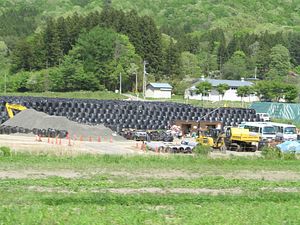When Fukushima prefecture invited Tokyo Electric Power Company to build a nuclear power plant in 1961, they took a chance – and eventually paid the ultimate price. It’s been 12 years since a massive magnitude-9.0 earthquake hit northwest Japan and triggered a 15-meter tsunami that slammed into the Fukushima Daiichi Nuclear Power Plant. The rest is history.
Currently, 2.4 percent of the prefecture remains a no-go zone. Background radiation levels in towns 20 kilometers around the disaster-stricken power plant are within safe levels. But affected towns like Futaba, Okuma, Soma, and Odaka remain virtually ghost towns.
Some residents say the prefecture was dying long before the nuclear accident. But, for some, March 11, 2011, was a literal death sentence. The earthquake and tsunami took the lives of 20,000 people and injured 6,000. Some 2,500 people are still reported missing.
The international nuclear and radiological event scale rates the Fukushima nuclear disaster at the same level as the 1986 Chernobyl accident. Even so, authorities say that Fukuhisma released only 10 percent of the radiation levels seen in Chernobyl.
In the immediate aftermath of the nuclear disaster, the sale of Fukushima fish and agricultural produce stopped. Global food export bans were also imposed on Fukushima rice, fish, and farm produce. More than a decade later, though only China maintains a formal ban, Fukushima has been fighting the reputational damage brought on by the nuclear accident. Rumors continue to plague the agriculture sector, and sales of Fukushima produce still hasn’t returned to pre-accident levels.
Local residents who have returned say interest in checking radiation levels of privately grown food has fallen significantly and is no longer a major concern. Most of the radiation food testing centers around affected areas have closed due to falling demand. Kobayashi Takenori of Todokedori, a local-run radiation measurement center in Minamisoma, told me that a few years ago they used to test as many as 600 food samples each month, but now they test less than a third of that.
The decontamination of the towns outside the no-go zones has been largely completed. But 12 years on, the issue of how to treat and dispose of contaminated soil remains. There has been little progress on the contaminated soil and objects currently being temporarily stored in container bags within the prefecture. Contaminated soil is piling up. There is an estimated 14 million cubic meters of soil with nowhere to go. It’s said to be 11 times the size of the Tokyo Dome stadium. The prefecture has a statutory deadline of 2045 to permanently dispose of it.
In 2016 the environment ministry announced a policy to recycle decontaminated soil with a radiation level of less than 8,000 becquerels per kilogram. It hopes to recycle the soil for public construction projects such as filling roads and railroads, as well as agricultural land development outside the prefecture. The amount of soil that can be recycled sits at around 75 percent of the total volume temporarily stored in Fukushima.
The ministry is piloting a recycle program in two locations in Tokyo, which includes the popular botanical gardens of Shinjuku Gyoen. It hopes to fill a garden bed not accessible to the public with the decontaminated soil. The water collected on a protective underlay sheet will be tested for safety and then discharged into the sewage system. Once the pilot project is completed, the soil will be brought back to Fukushima. But there have been objections by local Tokyo residents, and the project has no confirmed start date.
As a part of reconstruction and revitalization efforts, Fukushima authorities have been encouraging residents to return to hometowns that have been decontaminated. But after a decade, many former residents who evacuated have put down roots elsewhere. Instead, Fukushima is attracting a new type of young person in search of new opportunities.
Small scale farming is popping up again in areas where radiation levels have subsided. Also, Pioneer Village and Haccoba brewery in Odaka are attracting fresh university graduates and former office workers pursuing their small business dreams. Both small businesses sit on land that belongs to returnee Wada Tomoyuki, whose family has lived in the town for generations. The staff I met at both businesses say the prefecture offers financial incentives and long term support to get start-ups off the ground and, unlike most country towns, it fosters a progressive spirit.
The Fukushima Daiichi plant was constructed in 1967 to supply electricity to nearby Tokyo as the population and economy boomed. It was first praised for creating jobs and bringing money into the prefecture. But after experiencing a triple disaster – an earthquake, tsunami and nuclear meltdown – Fukushima residents firmly believe the risks outweigh the benefits.
Fukushima continues to implement the lessons it has learned from the accident. But it struggles to convey to the broader public the spirit of today’s Fukushima, which is a hive of creativity and forward thinking.

































